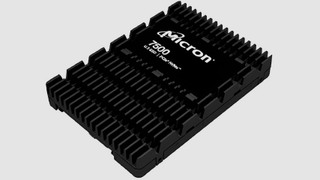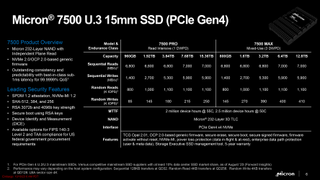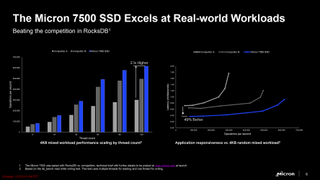Micron Unveils 7500-Series SSDs: 232-Layer 3D TLC NAND for Datacenters
Another lineup of datacenter PCIe Gen4 SSDs.

Micron on Monday introduced its 7500-series of SSDs that use the company's 232-layer 3D TLC NAND memory and slightly increase performance compared to the company's 7450-series drives. The new SSDs retain a PCIe Gen4 interface and address mainstream data center storage applications, including cloud servers and enterprise servers.
Micron's new 7500-series SSDs leverage the same controller and the platform originally introduced with the 7450-series drives. The new SSDs are not rebadged drives, but rather majorly revamped products with new firmware and different memory. As a result, Micron's 7500 SSDs have sub-1 ms Quality-of-Service (QoS) latency as well as lower latencies than as well as higher sequential and random read/write performance.

Micron says that the new 7500-series drives boast maximum sequential read speeds of up to 7,000 MB/s, as well as sequential write speeds of up to 5900 MB/s, which is slightly higher compared to 7450-series SSDs. As for random performance, we are talking about up to 1.1 million random read IOPS and up to 400 thousand random write IOPS, which is in line with what some of the best consumer SSDs offer. As for latencies, optimizations there were a key goals of developers, which is why Micron's 7500-series drive beats the competition in RocksDB (according to the company). Meanwhile, some of Micron's competitors use 3D QLC memory, which is why those drives, by definition, have worse latencies than the 7500-series.

Unlike Micron's 7450-series drives, the company's 7500 SSDs target mainstream NVMe datacenter applications and will only ship in U.3/U.2/15mm form-factors as these are the most popular server drive form-factors. From the capacity point of view, these new drives continue to offer a wide range of options starting from 800GB, going all the way to 15.36TB.

The company will continue to offer capacity-optimized read-intensive 7500 Pro drives with an up to 15.36 TB capacity and 1 drive writes per day (DWPD) rating, as well as endurance-focused mixed use 7500 Max SSDs with 3 DWPD rating.
One important addition to Micron's 7500 SSDs is compliance with TCG Opan 2.01 specification, as well as SPDM 1.2 attestation, SHA-512, 384, and 256 support as well as RSA encryption with 3072b and 4096b key strength. These security capabilities are required to win lucrative contracts with U.S. government, which has specific requirements for security capabilities.
The Micron 7500 family is now available from select OEMs and the company's channel partners. Prices depend on volumes and other factors.
Stay On the Cutting Edge: Get the Tom's Hardware Newsletter
Get Tom's Hardware's best news and in-depth reviews, straight to your inbox.


Anton Shilov is a Freelance News Writer at Tom’s Hardware US. Over the past couple of decades, he has covered everything from CPUs and GPUs to supercomputers and from modern process technologies and latest fab tools to high-tech industry trends.
-
Li Ken-un This series seems like it doesn’t have any stand-out features with its capacity topping out at a mere 16 TB. But looking at the technical specifications, it’s got something few SSDs have (from all the spec sheets I’ve seen): a 10^18 UBER.Reply
(The highest I’ve seen is 10^27 from Greenliant, and typically 10^17 for enterprise drives.) -
DaveLTX Which of the competitor products in this segment uses QLC??Reply
Only solidigm does and they're using it for capacity segment just like Micron?
Except their QLC SSD is DOUBLE the capacity! -
Li Ken-un The ION 6500 series also uses 232-layer TLC NAND. I wonder what’s going on in the 7500 series that’s capping the capacity to a mere 16 TB in 2023.Reply
Solidigm’s certainly didn’t get to 64 TB-class QLC SSDs by solely relying on QLC’s 33% greater density. Heck, that drives only uses 192-layer NAND. -
DaveLTX Reply
I suspect like it might be because they optimized the layout to use far less nand flash to reduce engineering costs, therefore it caps out at a lower capacityLi Ken-un said:The ION 6500 series also uses 232-layer TLC NAND. I wonder what’s going on in the 7500 series that’s capping the capacity to a mere 16 TB in 2023.
Solidigm’s certainly didn’t get to 64 TB-class QLC SSDs by solely relying on QLC’s 33% greater density. Heck, that drives only uses 192-layer NAND.
After all, kioxia managed 30.72TB with 96L flash and Micron somehow always managed to boast about industry leading
And the difference really is the Kioxia made a very intricate multi PCB design -
Li Ken-un Reply
Now that I look at the article’s main image, it would appear that of the 15 mm thickness, half of it is probably just the heat sink. That leaves 7 mm (a standard SATA drive thickness) for the actual PCB with the controller and memory chips.DaveLTX said:I suspect like it might be because they optimized the layout to use far less nand flash to reduce engineering costs, therefore it caps out at a lower capacity
3kX8Kyh -
bit_user Reply
It's seems like more of a system vendor, but I found this:DaveLTX said:Which of the competitor products in this segment uses QLC??
Only solidigm does and they're using it for capacity segment just like Micron?
https://www.storagereview.com/news/pure-storage-adds-75tb-flash-module-flasharray-e-and-new-flasharray-x-c-r4-nodes
Most Popular




